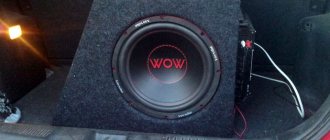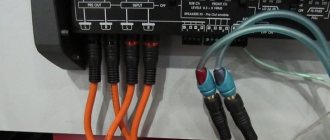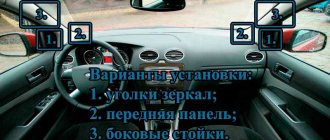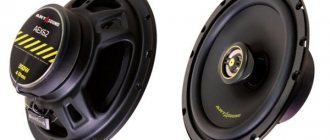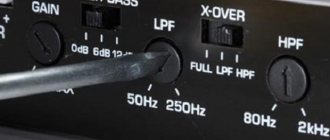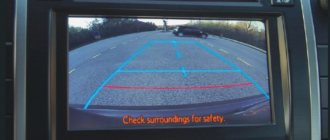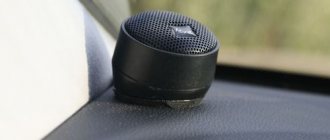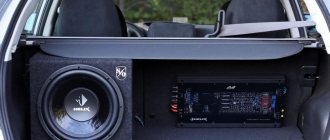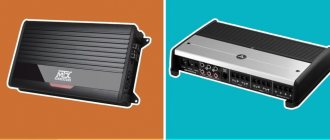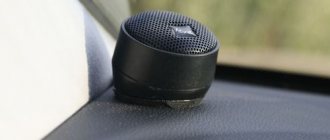High-frequency speakers (aka tweeters, aka tweeters) are used to reproduce high-frequency sound waves. Hence the name - tweeters. These are small-diameter speakers, they are placed on the A-pillars in the car, that is, they are aimed directly at the listener. All this together gives the car’s audio system detailed sound.
High-frequency speakers (hereinafter referred to as HF speakers) are fragile devices, so if they are connected incorrectly, you will not only not achieve perfect sound, but will also damage the speaker. This raises the question: “How to connect tweeters?”
What is a crossover
Crossovers are specialized devices in sound systems that create the necessary frequency ranges while the speakers are operating. In simpler terms, these are several filters for sound.
Externally, it is a housing with dimensions of approximately 12x6x4 centimeters, and inside this housing contains filters that are responsible for transmitting sound signals depending on their frequency. According to their main function, crossovers are divided into:
- High frequency (adjustable to frequencies from 80 to 100 Hz);
- Low-frequency (adjustable to frequencies from 2-5 kHz).
What kind of speakers are there?
Today, almost every car has a radio with speakers located in the front and rear and capable of pleasing the owner with decent sound. The market offers a variety of speaker systems that can satisfy the needs of even the most demanding music lovers. One simple option is to purchase a radio complete with speakers. A more difficult way is to correctly select and install acoustics that will match a specific car.
To get truly high-quality sound, you need to find out what types of dynamic heads exist. They are conventionally divided into:
- broadband;
- coaxial;
- component.
Wideband speakers reproduce the entire spectrum of sound frequencies that human hearing can perceive. It is precisely this kind of acoustics that, in most cases, is equipped with cars from the factory today. If you are a lover of good sound, then preference should be given to coaxial dynamic drivers. The set consists of several columns, the installation of which is carried out along one axis. The entire frequency spectrum, divided into low-frequency (LF), mid-frequency (MF) and high-frequency (HF), is reproduced by separate speakers. By dividing and expanding the frequency range, the sound quality can be improved. For lovers of high-quality music with powerful bass, you should consider a component system, which is usually used as front speakers. In addition to different types of acoustic systems, speakers are divided by standard sizes, the choice of which depends on the installation location and the goals pursued.
Acoustic systems are divided into broadband, coaxial and component. You need to give preference to one or another speaker depending on your goals.
What are tweeters used for?
Car audio systems often use tweeters or tweeters. Their main purpose is to reproduce high-frequency sounds. You can purchase the elements either separately or as a set with a multi-component system. In appearance, such devices are small speakers that can improve the sound in a car, making it even louder and more voluminous. They are usually installed at the back or front, which depends on the speaker system circuit used.
Tweeters in a car are designed to reproduce high-frequency sounds, and they are installed in the side pillars of the windshield, doors, and dashboard
Active and passive
Another classification is passive and active. The main difference between these two types is the components from which they are composed.
Active ones consist of components that require constant operation of power sources. These are, for example, microcontrollers, amplifiers and other elements.
As for passive ones, they are created from elements that do not require power, for example, coils, as well as capacitors and resistors.
Another difference is that active ones can only be mounted in front of the amplifier, while passive ones have more choice - they can be mounted in front of the speaker itself.
Choosing the right speakers and radio
First of all, specialized audio equipment is intended for installation in the car interior. Manufacturers of car speakers take into account not only sound quality, but also difficult operating conditions: vibration, dust, temperature changes, etc.
Is it possible to install household or variety speakers in a car?
Computer and concert speakers are designed for more gentle conditions. They most likely won't last long in a car.
In addition, computer speakers usually require not only a sound source, but also a separate power supply, without which they will not work, while car speakers are connected only to the output of an amplifier or radio.
As a rule, it is advisable to buy speakers where it is possible to evaluate the sound quality. Appearance does not play a special role, since in the car's interior the speakers are usually covered with a decorative mesh or grille.
Choosing suitable speakers for a car consists of determining the basic requirements for them and comparing the technical characteristics of several models of the same price category
Advantages and disadvantages
Active crossovers
- Convenience during operation;
- The switches are output directly to the housing.
- Too expensive;
- The need for active crossovers in amplifiers for channels;
- The presence of distortions in the work that arise due to the operation of the elements of these devices.
Passive crossovers
- Dividing signals into systems with several bands, and this requires only two amplification channels;
- Low cost.
- Impossibility of configuration without direct intervention in the entire electricity supply circuit;
- Select according to the acoustic system bands used;
- Configuration, selection and installation are processes that require professional knowledge and experience.
How to configure
In order to get the highest quality sound, you need to select the required cutoff frequency. If you use a three-way active crossover (the best option for most acoustic systems), you need to identify two cutoff frequency levels. The first shows the boundary between frequencies such as medium and low, and the second does the same, but for high and medium frequencies.
An important point: every vehicle owner must correctly determine the frequency characteristics of the speakers used before connecting the crossover to the speakers. There is no need to go to these frequencies, since in this case the crossovers will refuse to work normally at them. Ultimately, this will only lead to deterioration in sound and quality. This will also cause a reduction in the life of the equipment and the entire acoustic system in the vehicle.
Purpose
The main purpose of installing tweeters is to reproduce high frequencies. They are small speakers that are installed in the front and rear of the car (or in one of them), depending on the audio system. For maximum effect, they are used as part of multi-component audio systems, but can be found in retail sales (for example, from Pioneer). The advantages of the speakers include ease of installation - every car owner can connect the tweeters correctly.
Speakers for better sound
When installed in speaker systems, motorists install tweeters through a crossover - this is a device that provides operating ranges for the speakers. It separates frequencies when working with a multi-component audio system. This allows you to get the maximum effect from the system and ensure high-quality sound quality in the car.
Connecting tweeters to the crossover is quite simple, and to do this, you only need to read the audio system instructions. But there are times when you need to connect the tweeters in your car directly to the radio.
Connecting tweeters to the radio
Attention: installing tweeters without a crossover or other filters may affect the sound quality! The signal coming out of the radio is the same and will not be distributed across frequencies. It is not recommended to connect speakers this way, but it is possible.
It is possible to connect tweeters to speakers that are already installed. To do this, you will need a 1st order filter (capacitor). The capacity will depend on the installed speakers and is selected individually in each specific case.
Where is it placed?
Considering that the crossover cannot be installed in any place, it is worth noting those places that are suitable for installing speakers and amplifiers.
Requirements for installation sites:
- Absence of any leaks or dampness;
- Free and comfortable access for both connection and configuration;
- Excellent air circulation for cooling;
- The absence of any inconvenience or interference that is in any way related to the operation of the vehicle;
- Good visual appearance.
How to make universal podiums for speakers
In most cases, you can do without investing in the purchase of factory podiums and make the element yourself. It's not as difficult as it might seem at first glance.
To successfully make a podium you will need the following materials:
- plywood 6–8 mm thick;
- degreaser;
- cardboard;
- polyurethane foam;
- putty;
- glue;
- epoxy adhesive;
- nylon tights;
- dye;
- fabric or leather for covering.
In order to put your idea into practice without any difficulties, it is best to prepare the necessary tools in advance:
- scissors;
- hacksaw/jigsaw;
- pencil;
- stationery knife/blade;
- sandpaper;
- putty knife.
Almost all the tools and materials for making podiums are available on the farm of an experienced craftsman
Dimensions and shape of the acoustic podium
The technology described below involves the manufacture of podiums for speakers located in the front or rear doors of the car. Most often, there is one speaker with a diameter of 13 centimeters in the door. However, regardless of its size, the podium manufacturing technology will be the same:
- First you need to figure out what kind of podium shape is suitable for the interior of your car.
- It is necessary to measure both the dimensions of the existing speaker and the dimensions of its protective mesh.
- The diameter of the speaker ring will correspond to the diameter of the seat for it in the podium. And the outer diameter of the ring will be equal to the diameter of the protective mesh.
- Once you have approved the form, you need to draw it on a piece of cardboard.
- The resulting template must be carefully cut with scissors.
- Next, we apply the template to a piece of plywood and trace it with a pencil.
- For two doors we will need two plywood blanks that can be cut with a hacksaw or jigsaw.
- It is necessary to cut out the hole in the podium as accurately as possible, since if the proportions are violated, the speaker in the pocket will not be securely fixed.
Photo: correct procedure for making a shelf in a car door
The process of creating podiums for speakers does not end here. The workpiece must go through several more stages of design.
In order to give the plywood podium an attractive appearance, polyurethane foam is usually used. It is applied to the surface of the plywood. Then you need to do the following:
- when the foam has completely hardened, you need to work on the shape using a stationery knife or blade - you can give the workpiece absolutely any shape;
- After initial processing, you will need to apply one or two layers of putty to the product. After it has dried, you will need to give the podium the smoothest and most embossed shape possible by treating it with fine-grained sandpaper;
- the resulting product can be painted in any color, and it is advisable to paint in three layers for deep color saturation;
- As another design option, reupholstery is also allowed - that is, the use of elastic fabrics that can be attached using adhesives to decorate the podiums. You can cover the podium blanks with almost any type of fabric or artificial leather, but you should take into account the practicality of the material and its durability.
Installation
Features of how to connect crossovers to speakers include the following:
- Crossovers, as devices that help create the necessary frequencies and sounds on speakers, are connected to the entire audio system;
- All devices, regardless of the type of operation, have symbols located on stickers. Here, on the stickers located on the back, there are diagrams for connecting the active wires;
- After this, the cover is removed, since under it there are indications of the operation and working elements of the device in the general acoustic system of the vehicle;
- The next step is choosing a suitable installation location.
Types and purpose of tweeters
Tweeters are often used to create acoustic systems in automobile transport. They are designed to reproduce high frequency sounds. You can buy such elements separately or as a set with the system.
These devices are miniature audio speakers that improve the sound of music files in the car, making it more spacious and expressive.
The tweeters are mounted at the front or rear of the car interior. It depends on the acoustic circuit.
Installation and connection of tweeters from the radio is most often done on the dashboard, in the doors, in the windshield pillars.
Designations of modifications
Among the designations that crossover modifications for vehicles have are the following:
- Input, or entrance. It is to this place that the output of the active amplifier is connected, so it is important not to make a mistake with the polarity here.
- Woofer, or low frequency emitter. A speaker with mid and low frequencies is connected to this place. Separation stripes are indicated in the technical documentation.
- Twitter, or tweeter. A high-frequency speaker is connected to this location.
These are the main points and rules regarding how to connect crossovers to speakers and to the entire sound system of the vehicle.
Criterias of choice
Choosing the best car acoustics for your budget should begin with an analysis of reviews, reviews, and car audio forums. Professionals are always happy to share their opinions on popular speaker models. But choosing only online is a bad idea when looking for a kit for a car speaker system.
You need to find stores with listening stands where the speakers will immediately demonstrate their sound. After all, the main problem with such products is the different perception of both the overall sound picture and the sound of high, medium and low frequencies. People have different levels of musicality and needs. Therefore, reviews from owners and the opinions of experts need to be taken into account, but they cannot be guided by them - only live wiretapping.
The next step is to compare your budget and the models you like. Sometimes the cheapest system to install can turn out to be more expensive (cost of speaker cable, substitution, sometimes even protective mesh) than the initially more expensive one. It’s better to calculate everything in advance, because then you can get better speakers.
The choice also depends on the original components that are already in the car. For example, replacing standard cheap tweeters when there is only a radio in the cabin will require one system, and if you already have a sub, amplifier and rear ovals (“pancakes”), then a completely different one
In the first case, the presence of crossovers and a large diffuser diameter are very important. And in the second, you can try to extract sound from more budget speakers
It is worth taking into account the design features of the machine, standard mounting locations and speakers. Sometimes the choice of model is dictated by the installation size for fitting the speaker into the door, the reluctance to bother with mounting the podium and the need to fit into the standard 13 cm, etc.
There are practically no problems with the versatility of modern speaker kits; they connect with each other quite simply. You can easily assemble the head unit, new speakers and previously installed components into one system, if they are already installed. But it’s better to consult in advance on the forums of car audio specialists or audiophiles who are interested in acoustics.
Installation
1. Remove the windshield pillar trim (see instructions).
2. Remove the tweeter mesh by prying it off with a plastic spatula.
3. Secure the tweeter to the stand cover using hot melt adhesive.
4. We stretch the wires under the panel to the radio (see how to remove the radio).
Example of installation of Dynamic State NT-7.2 tweeters:
Connection
Standard tweeter connection diagrams for Lada XRAY (configurations: basic and luxury):
It is necessary to connect to the 12-pin connector of the radio (see radio pinout):
- left tweeter to pins 2 and 7
- right tweeter to pins 3 and 8
That is, “minus” to “minus”, and “plus” to “plus” through a capacitor.
Also, the tweeters can be connected parallel to the front speakers (just like on the Lada Vesta).
After installing high-frequency speakers, the sound in the Lada XRAY cabin will be more voluminous.
Let us remind you that we talked about the audio preparation of the Lada XRAY earlier. Will you install tweeters in your car? By the way, do you know how to activate the function of changing the radio volume depending on the speed on a domestic crossover?
Found an error? Select it and press Ctrl+Enter..
Similar materials
Top materials
News
Tuning
Who services your Lada XRAY?
Lada.Online
Lada (“Lada”) is a brand of cars produced by AvtoVAZ JSC. Previously, it was used only for export cars, and for the domestic market, cars were produced under the Zhiguli brand. In 2004, the management of AvtoVAZ announced the transition to the Latin alphabet for the official spelling of the names of all cars produced by the plant: Lada - instead of "VAZ" and "Lada".
Do-it-yourself replacement of standard speakers
The least expensive way to improve the sound inside a car, both in terms of money and effort, is to replace the standard wideband speakers with two- or three-way coaxial ones.
The standard place for the “native” speakers is the lower front corner of the doors. For replacement, it is advisable to select speakers of the same size as the standard ones. Larger speakers generally sound better, but they will require a larger mounting hole in the door.
Installation Tools
To replace the speakers you may need the following tool:
- jigsaw,
- electric drill,
- Phillips and flathead screwdrivers,
- knife,
- soldering iron,
- pliers,
- set of car keys,
- panel puller,
- file,
- insulating tape,
- plastic clamps for fastening wires.
In what places is it recommended to install tweeters?
Manufacturers recommend many places to place tweeters, most commonly at ear level. In other words, aim them as high as possible at the listener. But not everyone agrees with this opinion. This installation is not always convenient. It depends on the specific circumstances. And the number of installation options is quite large.
- Corners of mirrors. During the trip they will not cause additional discomfort. Moreover, they will fit beautifully into the interior of the vehicle;
- Dashboard. Installation can even be done using double-sided tape;
- Podiums. There are two options here. The first is to install the tweeters in a standard podium (which comes with the tweeter), the second is to make the podium yourself. The latter case is more complicated, but it guarantees a better result.
Where is the best place to point tweeters?
When designing car audio, you can choose one of two options:
- each tweeter is directed at the listener. That is, the right tweeter is directed at the driver, the left one is also aimed at him;
- Diagonal installation. In other words, the tweeter on the right is routed to the left seat, while the speaker on the left is routed to the right.
The choice of one option or another depends on the individual preferences of the owner. To begin with, you can point the HF speakers towards yourself, and then try the diagonal method. After testing, the owner himself will decide whether to choose the first method or give preference to the second.
How to choose a tweeter for a car
Published: 3 years ago
A tweeter (from English tweet - twitter, tweet) is a speaker designed for high-quality reproduction of high-frequency sounds in the audible range (2000-20000 Hz). Why is it needed?
Firstly, car manufacturers often skimp on the standard audio system and limit themselves to installing a pair of inexpensive full-range speakers in the doors. “Failure” of high frequencies on such speakers is a common occurrence. The problem can be solved by replacing the standard wideband speakers with coaxial ones, or by installing tweeters in addition to the standard ones.
| Component acoustics |
Secondly, the presence of tweeters is necessary if you value good sound and decide to install component acoustics in your car, i.e.
, such acoustics in which each frequency band is voiced by a separate speaker: HF - tweeters, MF - full-range speakers, LF - subwoofers.
Despite all the promise of coaxial acoustics, component acoustics are still considered the best solution for ensuring purity and sound quality.
Installation and connection of tweeters
Before you start choosing a tweeter model, it would be useful to decide on where to install them. Installing tweeters has several features that should not be forgotten so as not to be disappointed in their purchase:
- The human ear is very good at determining the direction of a high-frequency sound source, so tweeters should not be located at a great distance from the corresponding full-range speakers. If this requirement is neglected, a “floating” stereo effect may occur, in which the apparent direction to the sound source will change depending on the frequency. The maximum allowable distance is 6 inches - about 21 cm. Based on this, you should choose the location of the tweeter.
- if you have rear midrange speakers installed and they play at the same volume as the front ones, tweeters should also be installed at the back - to prevent the same “floating” stereo effect
- if the location of the tweeter is closer to the driver’s ear than the location of the wideband speaker, the tweeter should be selected with a sensitivity lower than that of the main speaker, otherwise the high frequencies will “crush” the rest with volume
- Many tweeters have a rather narrow directivity pattern, i.e., the sound quality deteriorates noticeably as the ear moves away from the directional axis. Therefore, both tweeters are either directed directly at the driver’s ears, or to a point between the front seats - then the deviation from the axes of both tweeters is the same, for both the driver and the passenger.
- there should be no obstacles between the tweeter and the listener
- The high-frequency sound of the tweeter is well reflected from the car windows, so the tweeters must be positioned so that the reflections of the sound cone from the windows do not enter the listener’s ears, distorting the sound picture. Imagine that instead of a tweeter you put a flashlight and you need to install it so that the reflection of the light from this flashlight in any of the glasses is not visible
- It is not necessary to place the tweeter directly in front of your ear, but it is worth raising it higher to reduce reflections that can occur (and degrade sound quality) when the tweeter is mounted in a door or at the bottom of the dashboard
| The sound picture for the driver and passenger is the same and balanced, since the deviations from the tweeter axes for both ears of both the driver and the passenger are also the same. | The sound picture is balanced for both driver and passenger, but the driver receives higher quality and louder sound |
Connection features
A tweeter is an element of a stereo system whose task is to reproduce sound with a frequency from 3000 to 20,000 hertz. The radio tape recorder produces a full spectrum of frequencies, ranging from five hertz to 25,000 hertz.
The tweeter can only reproduce high-quality car audio with a frequency of at least two thousand hertz. If a lower-frequency signal is applied to it, it will not be reproduced, and if the power for which the mid- and low-frequency speakers are designed is high enough, the tweeter may fail. At the same time, there can be no question of any quality of playback. For long-lasting and reliable operation of the tweeter, you should get rid of the low-frequency components that are present in the general spectrum. That is, make sure that only the recommended range of operating frequencies falls on it.
How to connect beepers in a car
High-frequency speakers (aka tweeters, aka tweeters) are used to reproduce high-frequency sound waves. Hence the name - tweeters. These are small-diameter speakers, they are placed on the A-pillars in the car, that is, they are aimed directly at the listener. All this together gives the car’s audio system detailed sound.
High-frequency speakers (hereinafter referred to as HF speakers) are fragile devices, so if they are connected incorrectly, you will not only not achieve perfect sound, but will also damage the speaker. This raises the question: “How to connect tweeters?”
Choosing an installation location
The task of correctly installing twitter (literal translation from English is chirping) is to direct high-frequency sound “directly to the ears.” At the same time, there can be many options for their location in the cabin.
- Install on the inner corners of the mirrors. They will not interfere and will fit well into the interior.
- Using double-sided tape (most tweeters already have it), place the HF speakers in any convenient place on the dashboard or rack. The option is simple and convenient.
- Make special podiums for tweeters. This is the most difficult option proposed and is suitable for people who know how to do anything with their own hands.
Other Features
Today, the most common tweeter option is the electrodynamic system. Structurally, it consists of a housing, a magnet, a coil with a winding, a diaphragm with a membrane, and power wires with terminals. When a signal is applied, current flows in the coil and an electromagnetic field is formed. It interacts with the magnet, mechanical vibrations occur, which are transmitted to the diaphragm. The latter creates acoustic waves, and sound is heard. To increase the efficiency of sound reproduction, the membrane has a specific dome shape.
Car tweeters typically use silk membranes. To obtain additional rigidity, the membrane is impregnated with a special compound. Silk is characterized by its ability to more effectively cope with high loads, temperature changes and dampness.
In the most expensive tweeters, the membrane is made of thin aluminum or titanium. This can only be found on very prestigious speaker systems. They are found quite rarely in a typical car audio system. The cheapest option is a paper membrane.
In addition to the fact that the sound is worse than in the two previous cases, such equipment has an extremely short service life. And this is not surprising, since paper cannot ensure high-quality tweeter performance in conditions of low temperature, high humidity and high load. When the car increases engine speed, an unusual sound may be felt.
Don't forget that you can also set up the tweeter using the radio. Even the cheapest models have the ability to adjust the high frequencies. In particular, mid-price models have a built-in equalizer, which greatly simplifies the task.
After installing the tweeter, you need to configure the audio system, and how to do this, read the article “How to configure a radio.”
How to connect a tweeter in a car - procedure and rules for performing the work
How to connect beepers in a car is one of the most common questions when planning the audio system of your car. The difficulties are due to the specifics of modern stereo systems. It is their complexity that often leads to serious distortions or malfunctions in the operation of high-frequency speakers.
Such “surprises” are not included in our plans, so the work must be carried out taking into account possible difficulties and aspects. Some dexterity and theoretical preparation are enough to not only buy acoustics in a car, but also to reveal its full potential when playing your favorite compositions.
How to connect a tweeter in a car - choose a location
The first and pressing question, which is the subject of numerous recommendations from manufacturers. But they all usually come down to the need to point the tweeters as high as possible at the listener.
Although not all users support this opinion. The main reason is that such a connection is not always convenient.
In each case, individual specifics must be taken into account. In fact, numerous installation and connection options are possible.
Possible locations for connecting tweeters
- In the corners of the mirrors - without discomfort during travel.
An affordable way to harmoniously complement the beauty of your car interior; - Dashboard.
If desired, installation can be limited to ordinary double-sided tape; - Podiums.
In this case, two options are possible: placing the tweeters in a standard podium (included), or making them yourself. The last option turns out to be noticeably more complicated, but if executed correctly it can significantly improve the quality of the result.
How to connect tweeters in a car - where is the best direction?
- Point each tweeter at the listener.
Consequently, beepers in the car are directed at the driver from both sides. - Diagonal connection of tweeters.
The left one will be directed towards the left seat, while the right one will be oriented towards the right one.
The specific option for connecting the tweeters depends on personal preference. You can experiment - first direct it towards yourself, and then implement the diagonal option.
It is this comparison that will allow us to determine the most comfortable and suitable option.
Features of connecting high-frequency speakers
Tweeters are designed to reproduce frequencies in the range of 3000-20,000 Hz. On average, a car radio is focused on the range of 5000-25,000 Hz.
The tweeter is capable of handling high-quality sound reproduction with a frequency of at least 2000 Hz. If you work with a lower-frequency signal, you cannot count on its reproduction.
And if the power supplied is too high, for which the low- and mid-frequency speakers are designed, there is a real threat of the tweeter breaking.
And in this case we are not talking about the quality of playback at all.
To ensure the stable and correct functioning of the tweeters, in any case, you need to exclude low-frequency components from the overall spectrum. Consequently, it is necessary to achieve only the recommended range of operating frequencies.
The simplest option for cutting off low frequencies is to connect tweeters in series through a capacitor. It allows you to effectively pass HF frequencies from 2000 Hertz and above. Frequencies below will simply be cut off. However, the capabilities of such a simple filter are quite limited.
Usually the speaker system already has a capacitor. Therefore, no additional costs will be required.
If you plan to connect tweeters through a capacitor using a used radio and if there is no such filter included with the tweeter, it must be purchased separately.
Various types of capacitor are possible:
- Installed on a wire;
- In the form of a special box to which a signal will be sent and then sent to the tweeters;
- Built-in automotive capacitor in the tweeter.
If the specified capacitor options are not available, you should purchase it separately and install it yourself.
Please pay attention!
With a higher signal frequency for the tweeter, the overall detail of the sound also increases.
